Poverty and Income Inequality in Scotland 2015/16
Estimate of the number and proportion of people living in poverty in Scotland in the financial year 2015/16.
This document is part of a collection
Chapter 2: Income Inequality and the distribution of income
Income inequality Measures
Just as there are a number of different measures of poverty, so there are multiple measures of income inequality. The Scottish Government focuses on two - the Palma Ratio, which is the measure underpinning the Solidarity Purpose Target; and the Gini Coefficient. These measure income inequality in slightly different ways.
2.1 Income inequality - the Palma ratio
Key points:
- The top 10 per cent of the population had 38 per cent more income in 2015/16 than the bottom 40 per cent combined. This compares to 15 per cent more income in 2014/15 indicating an increase in inequality.
- Income inequality increased quickly up to 2008/09 before decreasing again. Between 2010/11 and 2014/15 it remained largely unchanged but has increased sharply in 2015/16.
Caution should be used when comparing poverty rates between years.
This section provides information that relates to the Scottish Government's Solidarity Purpose Target which is "To increase overall income and reduce income inequality by 2017"
More information can be found at the following link:
http://www.gov.scot/About/Performance/scotPerforms/purpose/solidarity
Chart 6 shows the ratio of total income received by the top ten per cent of the population divided by the total income of the bottom forty per cent of the population (expressed as a percentage) from 1998/99 to 2015/16. This measure of how equally income is distributed across the population is known as the "Palma ratio" or "S90/S40 ratio". Palma is used internationally to estimate the extent of inequality between those at the top of the income distribution and those at the bottom and is used in Scotland to monitor progress towards the Scottish Government's Solidarity Purpose Target.
Chart 6 - Palma measure of inequality
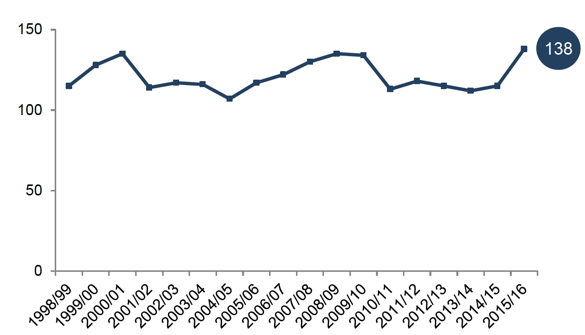
Source: HBAI dataset, DWP. These figures are also presented in Annex 1 (Table A15).
Commentary:
Income inequality in Scotland increased gradually up to 2008/09, before falling following the onset of the recession. In 2010/11, income for the top 10 per cent fell, resulting in a reduction in income inequality. It remained largely flat until 2014/15, but increased sharply in 2015/16. Once again further years' data will be required to determine whether this is the beginning of a longer term increase or due to annual variation. The increase was mainly due to large increases in incomes at the top of the distribution although incomes at the bottom also fell. It is now at its highest level since reporting began in 1998/99. The increases in income at the top of the distribution were driven by increases in employment earnings income.
2.2 Income inequality - the Gini coefficient
Key points:
- The Gini coefficient, which measures the degree of inequality in household income, was 34 in 2015/16. This is an increase from 31 in 2014/15, due to increases in incomes at the top of the distribution and decreases at the bottom.
Caution should be used when comparing poverty rates between years.
The Gini coefficient is a measure of how equally income is distributed across the population. It takes a value between 0 and 100 with 0 representing perfect equality where every person has the same income. The larger the Gini coefficient, the more people towards the top of the income distribution have a greater share of overall income with a value of 100 representing the case where one individual has all the income. In practice, the proportion of overall income going to each individual increases gradually across the income distribution.
For Scotland, the Gini coefficient has been between 30 and 34 over the last decade. In 2015/16, the Gini coefficient for Scotland was 34, a three percentage point increase compared with 2014/15.
Chart 7 - Inequality of household income as measured by the Gini coefficient
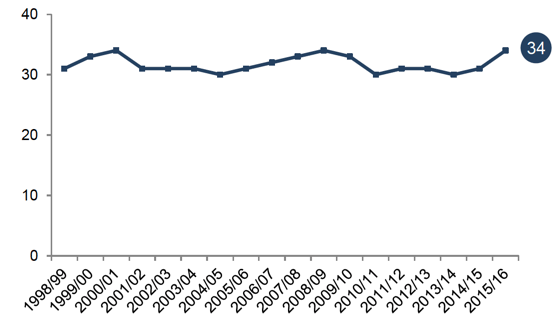
Source: HBAI dataset, DWP. These figures are also presented in Annex 1 (Table A14).
The Gini coefficient shows a similar trend to the Palma ratio, with income inequality rising until the recession and then falling in 2010/11. This was largely driven by a fall in income to the top 10 per cent. Income inequality remained relatively stable until 2014/15. The increase in the latest year was largely driven by increases in the top ten per cent, due to earnings income increasing for this group.
2.3 Income thresholds
Key points:
- Median income in Scotland in 2015/16 was £24,400, equivalent to £468 per week. Median income in Scotland has decreased in 2015/16 by £600, equivalent to £11 per week.
- The poverty threshold BHC in 2015/16 was £15,000, equivalent to £288 per week. The poverty threshold BHC increased in 2015/16 by £200, equivalent to £4 per week.
- After housing costs, the poverty threshold in 2015/16 was £12,900, equivalent to £248 per week. The poverty threshold AHC also increased in 2015/16 by £300, equivalent to £5 per week.
- A couple with no children with a combined income of over £39,000 (after tax and benefits) would be in the highest income 20 per cent of the population. With an income over £47,500 they would be in the top 10 per cent.
Caution should be used when comparing poverty rates between years.
Most of the income figures in this publication are based on equivalised income. One consequence of the equivalisation process is that there are different poverty thresholds for households of different sizes and compositions. To help readers understand the figures in this publication, Table 1 below presents some commonly used income thresholds, before equivalisation, for households of different sizes.
The incomes presented elsewhere in this report use the value for "Couple with no children" as the standard, and all other household types are adjusted to reflect their different household composition.
Table 2 shows the same information after housing costs have been taken into account.
Table 1 - Income thresholds (£) for different household types before housing costs (income after tax and transfers) - 2015/16
| Single person with no children | Couple with no children | Single person with children aged 5 and 14 | Couple with children aged 5 and 14 | |||||
|---|---|---|---|---|---|---|---|---|
| weekly | annual | weekly | annual | weekly | annual | weekly | annual | |
| UK median income (before housing costs) | 322 | 16,800 | 481 | 25,100 | 577 | 30,100 | 735 | 38,300 |
| Scottish median income (before housing costs) | 313 | 16,300 | 468 | 24,400 | 561 | 29,300 | 716 | 37,300 |
| 60% of UK median income (before housing costs) - relative poverty threshold | 193 | 10,100 | 288 | 15,000 | 346 | 18,000 | 441 | 23,000 |
| 60% of inflation adjusted 2010/11 UK median income (before housing costs) - absolute poverty threshold | 186 | 9,700 | 278 | 14,500 | 333 | 17,400 | 425 | 22,100 |
| Scottish 1st income decile | 161 | 8,400 | 240 | 12,500 | 288 | 15,000 | 367 | 19,100 |
| Scottish 2nd income decile | 207 | 10,800 | 309 | 16,100 | 371 | 19,300 | 473 | 24,700 |
| Scottish 3rd income decile | 241 | 12,600 | 359 | 18,700 | 431 | 22,500 | 550 | 28,700 |
| Scottish 4th income decile | 275 | 14,400 | 411 | 21,400 | 493 | 25,700 | 628 | 32,800 |
| Scottish 5th income decile | 313 | 16,300 | 468 | 24,400 | 561 | 29,300 | 716 | 37,300 |
| Scottish 6th income decile | 365 | 19,000 | 545 | 28,400 | 654 | 34,100 | 833 | 43,500 |
| Scottish 7th income decile | 425 | 22,200 | 635 | 33,100 | 762 | 39,700 | 971 | 50,600 |
| Scottish 8th income decile | 501 | 26,100 | 748 | 39,000 | 897 | 46,800 | 1,144 | 59,600 |
| Scottish 9th income decile | 611 | 31,800 | 912 | 47,500 | 1,094 | 57,000 | 1,395 | 72,700 |
Source: HBAI dataset, DWP.
Note: to create ten decile groups only nine decile points are needed to split the population.
Table 2 - Income thresholds (£) for different household types after housing costs (income after tax and transfers) - 2015/16
| Single person with no children | Couple with no children | Single person with children aged 5 and 14 | Couple with children aged 5 and 14 | |||||
|---|---|---|---|---|---|---|---|---|
| weekly | annual | weekly | annual | weekly | annual | weekly | annual | |
| UK median income (after housing costs) | 239 | 12,500 | 413 | 21,500 | 495 | 25,800 | 669 | 34,900 |
| Scottish median income (after housing costs) | 244 | 12,700 | 420 | 21,900 | 504 | 26,300 | 681 | 35,500 |
| 60% of UK median income (after housing costs) - relative poverty threshold | 144 | 7,500 | 248 | 12,900 | 297 | 15,500 | 401 | 20,900 |
| 60% of inflation adjusted 2010/11 UK median income (after housing costs) - absolute poverty threshold | 138 | 7,200 | 237 | 12,400 | 285 | 14,800 | 384 | 20,000 |
| Scottish 1st income decile | 101 | 5,300 | 174 | 9,100 | 209 | 10,900 | 282 | 14,700 |
| Scottish 2nd income decile | 144 | 7,500 | 249 | 13,000 | 298 | 15,500 | 403 | 21,000 |
| Scottish 3rd income decile | 178 | 9,300 | 308 | 16,000 | 369 | 19,300 | 499 | 26,000 |
| Scottish 4th income decile | 208 | 10,800 | 359 | 18,700 | 430 | 22,400 | 581 | 30,300 |
| Scottish 5th income decile | 244 | 12,700 | 420 | 21,900 | 504 | 26,300 | 681 | 35,500 |
| Scottish 6th income decile | 284 | 14,800 | 489 | 25,500 | 587 | 30,600 | 793 | 41,300 |
| Scottish 7th income decile | 334 | 17,400 | 575 | 30,000 | 690 | 36,000 | 932 | 48,600 |
| Scottish 8th income decile | 401 | 20,900 | 691 | 36,000 | 829 | 43,200 | 1,119 | 58,400 |
| Scottish 9th income decile | 495 | 25,800 | 853 | 44,500 | 1,023 | 53,400 | 1,381 | 72,000 |
Source: HBAI dataset, DWP.
Note: to create ten decile groups only nine decile points are needed to split the population.
Deciles / decile points:
Deciles (or decile points) are the income values which divide the Scottish population, when ranked by income, into ten equal-sized groups. Therefore nine decile points are needed in order to form the ten groups. Decile is also often used as a shorthand term for decile group; for example 'the bottom decile' is used to describe the bottom ten per cent of the income distribution.
Decile groups:
These are groups of the population defined by the decile points. The lowest decile group is the ten per cent of the population with the lowest incomes. The second decile group contains individuals with incomes above the lowest decile point but below the second decile point.
2.4 Trends in income distributions
Key points:
- Scottish median household income decreased in 2015/16 both before and after housing costs.
- Median household income for households with children in Scotland decreased in 2015/16, after an increase the year before and remains below the level seen in 2009/10.
- Median income for working age adults in Scotland remained steady (a £1 increase) in 2015/16.
- Median income for pensioners in Scotland decreased having reached its highest level since reporting began the previous year.
- In 2015/16, the bottom five deciles all saw decreases in income compared to the previous year. The largest decrease was in decile 5 where income fell by £11 per week (£574 per year).
- The largest increase was in decile 8 where weekly incomes increased by £26 per week (£1,341 per year).
Caution should be used when comparing poverty rates between years.
Chart 8A - Median weekly household income in Scotland (in 2015/16 prices)
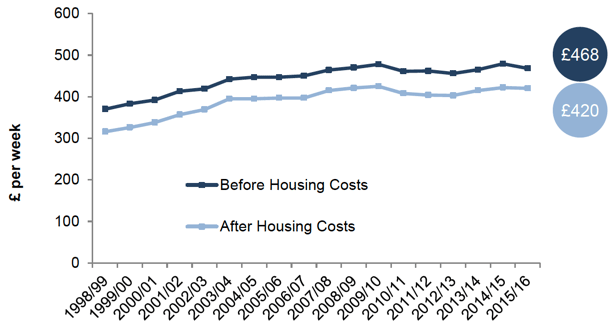
Source: HBAI dataset, DWP. These figures are also presented in Annex 1 (Table A8).
Chart 8B - Median weekly household income BHC in Scotland for children, working age adults and pensioners (in 2015/16 prices)
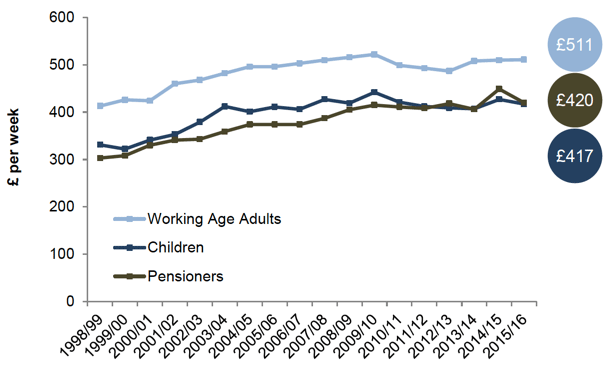
Chart 8C - Median weekly household income AHC in Scotland for children, working age adults and pensioners (in 2015/16 prices)
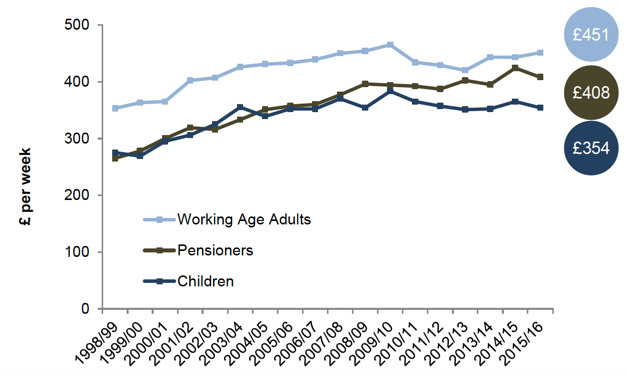
Source: HBAI dataset, DWP. These figures are also presented in Annex 1 (Table A9).
As for poverty rates reported in this publication, single year changes in household incomes may not be statistically significant.
In 2015/16, median household income was £468 per week (£24,400 per year), a decrease of £11 (£574 per year) compared with 2014/15. This decrease in median income follows two years of increases which had seen it return to the peak of 2009/10. Median income had been increasing for the 10 years to 2009/10, then decreased to 2012/13. All incomes are quoted in 2015/16 prices.
Median income after housing costs followed a similar trend to median income before housing costs and fell slightly in the latest year. It remains below the peak in 2009/10.
Commentary:
Chart 9 shows how the weekly equivalised incomes have changed from 2011/12 to 2015/16 across the different income decile points. Decile points are the incomes that separate out the 10 deciles, so 10 per cent of the population have household income below the 1 st decile point and 90 per cent of the population have income below the 9 th decile point. Charts 10 and 11 show the change in each decile point in the latest year, in percentage terms (Chart 10) and in pounds per week (Chart 11).
Chart 9 - Weekly household incomes for each decile point from 2011/12 to 2015/16
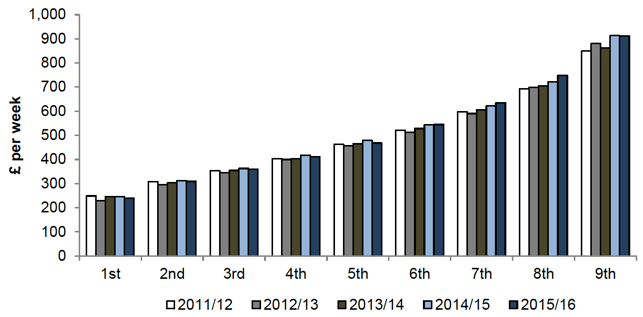
Chart 10 - Percentage change in each decile point between 2014/15 and 2015/16 (in real prices)
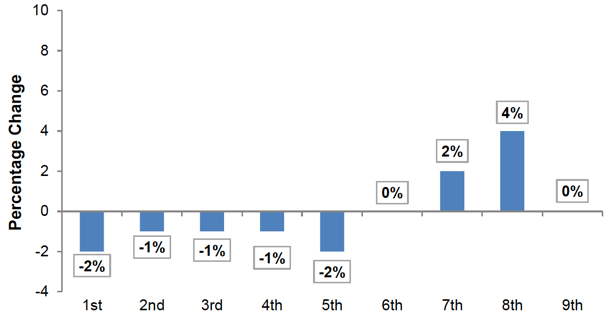
Chart 11 - Change in weekly income (£) by decile point between 2014/15 and 2015/16 (in real prices)
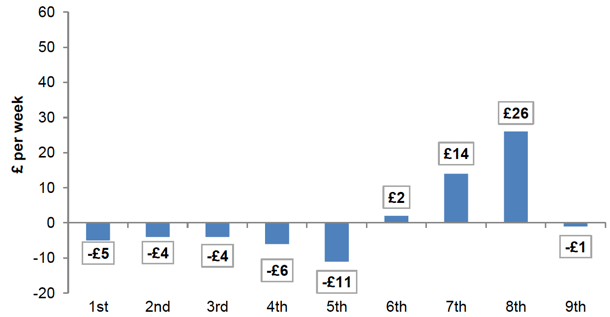
Source: HBAI dataset, DWP. These figures are also presented in Annex 1 (Table A10).
In 2015/16, the bottom 5 deciles saw decreases compared to the previous year. This was mainly due to income from earnings decreasing for this group. Incomes increased for deciles 6, 7 and 8 but decreased slightly for decile 9. The largest decrease was for the 5 th decile which fell by £11 per week whilst the largest increase was in the 8 th decile which rose by £26 per week.
Chart 12 below shows the distribution of weekly income across Scotland in 2015/16. The shaded area shows the shape of the 2015/16 income distribution and the black dashed lines show the Scottish median income (£468), UK median income (£481) and the relative poverty threshold BHC (£288). The dark blue line superimposed shows the 2014/15 income distribution for comparison.
Chart 12 - Distribution of Scottish weekly household income with Scottish and UK median and relative poverty threshold BHC - 2015/16
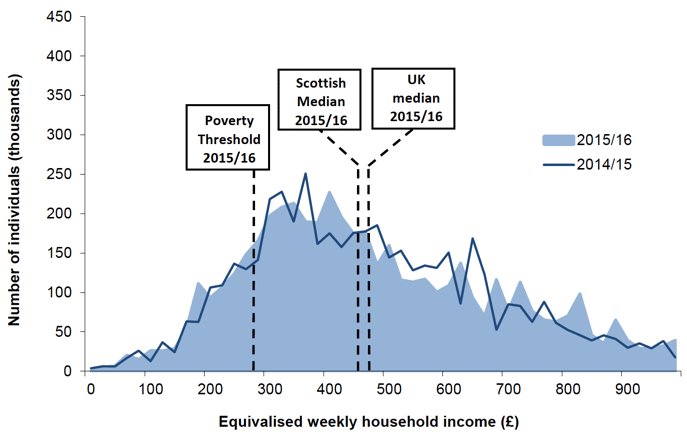
Source: HBAI dataset, DWP.
Chart 13 shows the same distribution with income deciles for Scotland marked with black lines.
Chart 13 - Distribution of Scottish weekly household income with income decile points
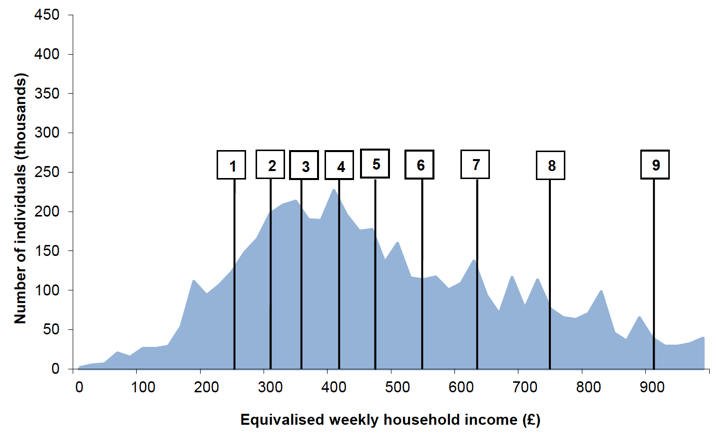
Source: HBAI dataset, DWP.
The relative poverty threshold BHC is based on the UK median equivalised household income. Unlike in Scotland, UK median income increased in 2015/16 and so the poverty threshold also increased, by £4. This means that those on low incomes need a higher income in 2015/16 to be above the poverty threshold, reflecting the greater increases in income for middle income households across the UK compared with low income households.
Contact
Email: Andrew White
There is a problem
Thanks for your feedback